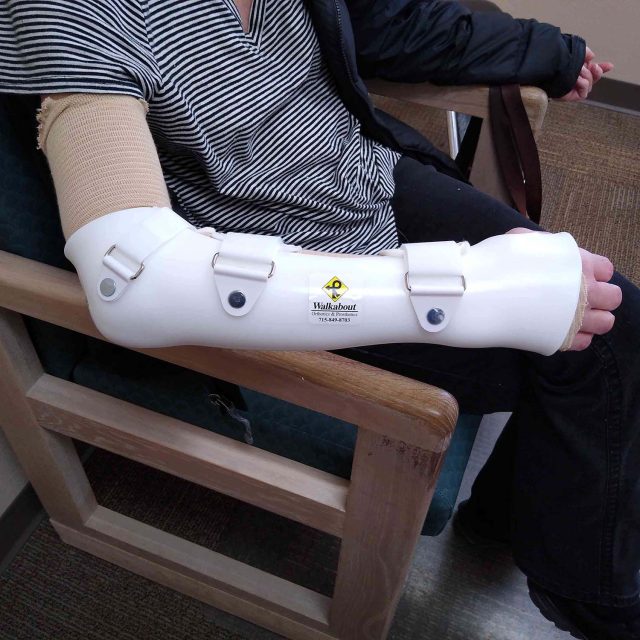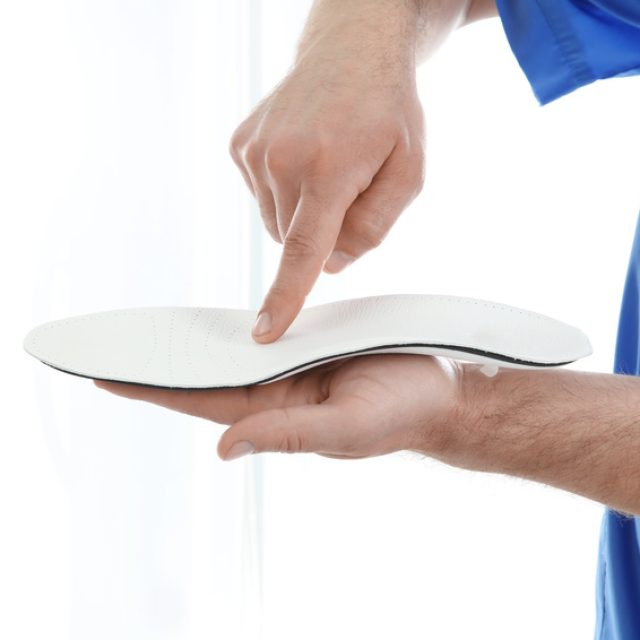
Meunster-Style Ulnar Fracture Orthosis
This is a meunster style ulnar fracture orthosis. Patient fractured ulna (large forearm bone). Physician order this for patient to wear after she got out of her splint. This brace is for long-term use. This brace will prevent rotation that will allow the fracture to heal without compromise.

How To Tell If Your Orthotics Have Seen Better Days
As of 2012, approximately 126.6 million Americans are currently living with musculoskeletal disorders. These disorders may be treated with surgery but in many cases are better cared for using orthotic services. However, orthotics such as walking boots, a prafo boot, a pressure relief shoe, and a plantar fasciitis night splint can wear out over time. Like many devices, orthotics get worn out with wear and tear the longer you use them. And, by definition, these devices suffer a lot of wear and tear. But how can you be sure whether or not your orthotics have started wearing out? Consider the following signs you may need to visit your orthotic services for improved support. Signs your orthotics have seen better days Custom orthotics, like custom prosthetics, are constructed from durable materials. This is because your orthotics, especially when used on the feet, will be handling a great amount of pressure to help your ligaments, tissue, or bones heal correctly. To test whether or not your orthotics may be wearing out, begin by pressuring down on the arch of the orthotic device. If the material of the arch (typically cork, foam, or plastic) begins to collapse under the pressure it may be […]
How Can Walking Boots Improve Plantar Fasciitis?
Orthotics are designed to help improve a person’s mobility or to prevent a musculoskeletal injury from worsening. For instance, a spinal orthosis has been known to prevent curving spines in up to 80% of the patients who wear them. Walking boots differ from spinal orthotics, but they work in a similar way. That is, they’re worn for enhancing mobility. While they’re often worn by those who have tendonitis or are recovering from ankle injuries, walking boots can also be worn by those suffering from plantar fasciitis. What is plantar fasciitis? Plantar fasciitis is a condition where the band of tissue connecting the ankle to the toes becomes inflamed. This inflammation can cause a stabbing pain in the foot and makes it difficult to walk. Depending on the patient, the pain may be worse in the morning. Plantar fasciitis is often caused by poor arch support or wearing shoes with a lack of general foot support. This condition is often treated with physical therapy or surgery. However, orthotic services and walking boots can also help to improve movement with plantar fasciitis. Using walking boots for plantar fasciitis A walking boot not only enhances mobility but can also reduce tension and inflammation […]
Above The Knee Prosthetic Legs: How To Take Your Silicone Liner with Pin System Prosthesis On And Off
In the United States, up to 185,000 people receive an amputation procedure every year. Many of those who receive an amputation procedure may eventually decide to get prosthetic limbs for enhancing mobility. Custom prosthetics above the knee allow for those experiencing limb loss to have greater freedom of movement. However, while it can be difficult to learn to walk with a prosthesis, it can also feel challenging to adapt to putting the prosthetic leg on and taking it off. Taking off an above the knee prosthetic leg To remove your above the knee custom prosthetic, begin by sitting down and relaxing your leg. Press the depress release button on the top most part of your prosthesis. Gently and slowly move the prosthesis just a little from the remaining part of your leg and release the button. Then proceed to slowly pull the prosthetic socket from your leg. Should you experience any problems removing the prosthetic socket, attempt to push your leg into the socket more as you press the depress release button. This will help to release the pressure on your leg and allow you to remove it from the prosthetic. After removing your leg from the prosthesis, check the […]
How Custom Orthotics Can Enhance Your Mobility And Improve Your Life
Many patients who suffer from foot pain believe there’s nothing that can be done to offer them relief when they walk. However, this isn’t true. In the United States, there are more than 3,000 patient care facilities that offer their patients prosthetic and orthotic services. Custom orthotics are one of the best ways to provide support for your feet for enhancing mobility and to help your entire body feel better. If you’re still considering whether custom orthotics are the right choice to reduce your foot pain, consider these following… Life-changing benefits custom orthotics offer. General foot support Your feet are considered to be the protective foundation for the rest of your body. Pain felt in the feet is often felt in other parts of the body as well because it’s such a sensitive area. Orthotics that are custom-made for your feet provide generalized support for over 100 muscles and all 26 bones in your feet. They also help to protect all three arches in your feet, giving you a strong foundation for when you plant your feet on the ground. Reduces stressful pronation Pronation is a natural foot movement, but it can cause stress and pain on the rest […]
Commonly Asked Questions About Customized Prosthetics: Part 2
In our previous post, we answered some commonly answered questions concerning custom made orthotics and prosthetic limbs. Here we continue with our list in hopes of explaining more about orthotic services and how they can help in enhancing mobility. Q: How much does a prosthetic limb cost? A: As these accessories are entirely custom to your needs, the prices do range. However, depending on your health care plan, they can be covered by insurance and you may not have to pay a penny out of pocket. Q: How long do I have to wait to get a prosthesis? A: It wholly depends on how you recover from amputee surgery. Depending on your injury you may get a temporary prosthesis immediately after surgery while you wait for a prosthetist to make you a customized accessory. However, generally speaking, you will have to wait until your residual limb has healed completely after surgery as the incision has to be fully healed and the swelling has gone down to get properly measured. Q: What is a K-level and why is it important? A: Health insurance companies, specifically Medicare, utilize a K-level system that analyzes your rehab potential. This is a way for them […]
Commonly Asked Questions About Customized Prosthetics: Part 1
Limb loss is very common in the United States, as there are approximately 1.9 million people across the nation that are living as an amputee. You may now be at the point in your life where you are considering visiting a prosthetist to find out your options for custom prosthetics, but you may have a lot of questions. To prevent confusion, here are some commonly asked questions about orthotic prosthetic limbs to decide if this option is the best for you. Q: Why would I use a prosthetic limb? Depending on personal preference, there are plenty of reasons to use a prosthetic. As an artificial replacement for a missing limb, these accessories can really help boost your quality of life and help you reach your personal goals. If you are questioning getting a prosthesis, some questions you can ask yourself include: Do I require a prosthesis to complete activities such as running or walking every day? Do I care about how my limb loss affects my personal appearance? What will I be able to do with my prosthesis if it was customized exactly for me? Answering these questions may be able to help you come to terms with […]

